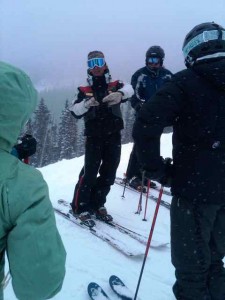Colorado Skiing & Snowboarding Telluride: Colorado Ski School Skiing & Snowboarding Telluride
by maribeth
Comments Off on Ski Instructors in Training: Precision Skiing 201
Ski Instructors in Training: Precision Skiing 201
Precision Skiing 201. Wow, even that title is intimidating. This is the name of a PSIA (Professional Ski Instructors of America) Clinic I took this winter. The numbers 201 indicate that it’s part of the training for Level 2 Certification, a distinction of excellence largely achieved by being able to ski and teach perfect parallel turns on a variety of terrain. As for the precision skiing part, nobody is more precise about technique than the ski geeks at PSIA. And since I’m a member of PSIA, I try hard to be as geeky about skiing as the best of them. (It’s rare that a ski instructor has the luxury of mindlessly cruising down the mountain. Instead we’re plagued with contemplating every aspect of our skiing from angulation vs. inclination to whether we’re fore or aft; well, you get the idea.)
Sometimes I shake my head and I still can’t believe I’m a ski instructor. Whenever I sense fear in a student I like to share that it wasn’t until I became a ski instructor that I stopped having butterflies in my belly the first couple of runs of the day. The best way to conquer fear is to face it head on. So now here I was feeling like a kid in school—butterflies and all—in my first PSIA clinic of the season.
I admitted to C. T. (Chris Thomsen), a PSIA examiner, a Telluride ski instructor and our clinician, that I felt somewhat jittery (about what I’m not sure, perhaps the scrutiny of it all). His reassuring smile and warm, friendly approach helped to put me at ease. Already I was grateful ten times over that I was able to take this clinic in Telluride, my home mountain. (For all the others, I had to travel to other destinations within the Rockies.) C.T. took charge of our group of ten ski instructors much like we strive to do in our regular lessons.
After a couple of warm up runs, we launched into a few drills, just the kind of thing we might introduce to our students, depending on what they needed to work on. We began with shuffling through our parallel turns on a blue run. Not only did I feel goofy doing this (and I’m sure I looked just as silly), but it also proved to be a bit of a challenge, especially on the steep pitches. I soon learned that you could only properly do this maneuver when in perfect balance, the holy grail of good skiing.
I was counting on this exuberant burst of energy (as if doing a perfect turn isn’t difficult enough, imagine shuffling through many of them) to warm me up. This brutally cold and snowy day became even harder to endure with every frequent stop. Explanation, instruction and demonstration is typically a huge part of any lesson, particularly a program like today’s. Still, I reminded myself that I was a Professional Ski Instructor of America, part of the hearty core of American society that can endure harsh outdoor elements, all for the betterment of mankind, or at least to improve my skiing and to help others gain the skills that would make a difference in their own on-snow performance.
C.T., a wiry guy of slight build, exuded tremendous enthusiasm and boundless energy. I wondered why he wasn’t getting cold. I felt chilled to the bone and I’m padded with at least five times the amount of body fat as him. But then I admitted to myself that he was more of a professional than me, fully realizing that his task at hand was far more important than frozen toes. Careful to critique everyone’s skiing and demos as they passed, he possessed a remarkable skill for zeroing in on the component that needed to be corrected in order to make a difference in our skiing. Indeed he was blessed with the keen eye of an examiner.
“Tip before you turn,” he called out to me as I completed my own series of dynamic parallel demos. “In modern skiing, you tip your skis on edge and then input rotary,” he explained. “That will give your skis support rather than sliding down the hill.” I found myself thinking “tip and turn” the whole rest of the day.
Just like in a group lesson, C.T. was sure to give us attention both as individuals and as a group, and in turn we supported each other in a similar fashion. Everyone had the same goal: to work on our skiing and to learn how to impart this knowledge to others. The geek factor grew throughout each drill which also included balancing our poles on our wrists as though we were carrying a large tippy tray down the slope and dragging the poles on the snow. The goal was the same for all: establishing a perfectly balanced stance that would enable us to be most efficient in our skiing. As with our students, we found that different things resonated with different people.
At lunch we talked about the PSIA Teaching Model which includes the following format: introduction, determine goals, create lesson plan, present and demonstrate information, check for understanding, practice and review. For kids, it’s play, drill, adventure. There was much talk about the CAP Model which is an acronym for cognitive, affective and physical, stages of development that one must especially keep in mind when teaching children.
Our afternoon consisted of practice on the bumps and an endless array of wedge christie demos, something I found to be onerous on blue terrain. (Skis—especially today’s shaped ones—automatically want to glide into a parallel rather than push into a wedge. If only novice skiers could get this feeling right off, they’d save themselves a lot of effort and soreness.)
C.T. chatted about DIRT which stands for duration, intensity, rate and timing. By now I was feeling like how my students must feel at the end of a full-day lesson: weary and somewhat on overload yet quite satisfied. My skiing had been tweaked. I was now thinking more about “short leg, long leg” on my dynamic parallel turns and thanks to C.T., I had stuffed a bunch more drills and teaching aids into my bag of tricks.
He cheerfully thanked all of us for our attention at the base of the mountain. His exuberance had never waned. For a geek, he’s one heck of an outgoing guy. I would do well to emulate his approach. I think PSIA is on to something.
Thank you to fellow ski instructor, Todd Brown, for the above photo.



